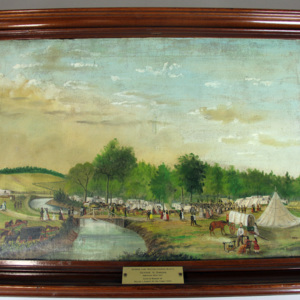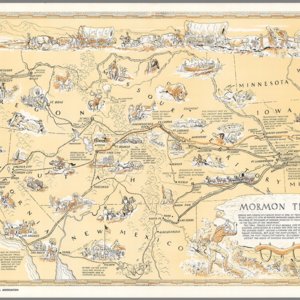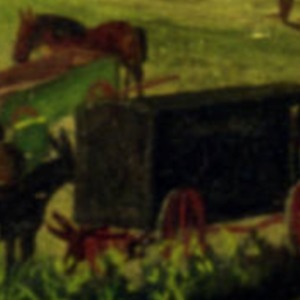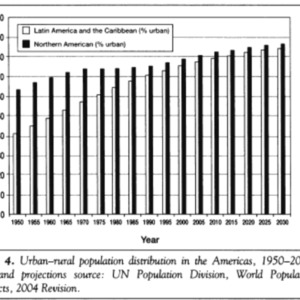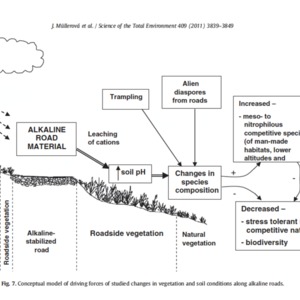Mormon Camp Meeting Painting
Title
Subject
Description
When the word ‘migration’ comes to mind, one may think of animals traveling south for winter or people relocating to distant new lands, seeking refuge or opportunity. However, migration involves more than just the movement of people or animals. Its effects extend deeper, leaving an impact on the environment itself. The Mormon Trail is one such example of human migration that left a stark impact on the land. The trail, beginning in Nauvoo, Illinois, was the route people of the Mormon religion used to get to Salt Lake, Utah while fleeing religious persecution. From 1846 to 1868, over 15,000 Mormon migrants trekked across the 1,300 mile-long trail. The painting “Mormon Camp Meeting, Council Bluffs” by artist George Simons, depicts a stop along this trail and is representative of the social as well as environmental significance of this movement. (Figure I) The movement on the Mormon Trail is not unique: migration is omnipresent in human history and has been a constant in the human story. Migration contributes to the settlement of new countries and the exploration of foreign lands. This painting reminds viewers that the Anthropocene is more than a story of settlement, urbanization, and agriculture. The Mormon Trail represents all human migration and the effects it has on the global environment. Migration is not inherently good or bad on its own; however, the methods used for migration have had and continue to contribute negatively to the Anthropocene.
Movement is an unusual object of environmental historical analysis, but images offer unique evidence of its significance. This painting depicts the Winter Quarters settlement of the Mormon Trail, which later became the cities Omaha and Council Bluffs. The settlement is split into two sections, divided by a stream or narrow river. Tents and covered wagons are depicted on the right side of the painting and are presumably the primary shelters used at this settlement. These dwellings are simple and representative of the few resources migrants have had. Animals are also depicted, often alongside the wagons they pull. These horses were vital for movement on the trail and without them the journey would have been longer and more arduous. Near some of the horses, are handcarts. While not as effective as animal-drawn transportation, handcarts were commonly used to transport smaller goods. The depictions of these tools highlight the elements necessary for all forms of land migration.
Migration involves more elements than just the movement of people. The attire of the people depicted in the painting can also be associated with the values of these migrants. People are wearing formal attire, despite travelling and living modestly. Clearly the Mormons prioritized personal presentation more than communal presentation. Painting, as a medium, imitates the physical appearance of a scene, although it also presents the ideas associated with its subject. The painting is an interesting piece to look at on its own, but knowing the story behind the painting sheds a new light on what it is attempting to convey. The Mormon Camp shown in the painting is merely a small snapshot of a much bigger picture, for Council Bluffs was just a stop along the way for the Mormons.
The painting was produced by a well-known artist to the area, George Simons, and represents a time sometime between 1834 and 1917. It is based off sketches Simons made while documenting the Mormon exodus. Simons arrived in Council Bluffs between 1849 and 1855, when the region was known as Kanesville (Gregory, 16). The physical state of the artwork today helps convey its age—the paint is beginning to crack and fade over the canvas. These works of art help give a visual record of what Omaha and Council Bluffs may have looked like at the time. Eventually, his painting, Mormon Camp Meeting, Council Bluffs, ended up in possession of the Durham Museum in Omaha. The exact timeframe of the painting’s creation is unknown. A rough range of dates is limited only by Simons’ own lifespan (1834-1917), and the time of the subject depicted: the Mormon Trail (1846-1868).
Mormonism took root far east of Council Bluffs, in upstate New York. There, a religious leader, Joseph Smith (December 1805 – June 1844), claimed to have received a set of golden plates from an angel, from which he wrote the Book of Mormon in 1830 and founded the Church of the Latter Day Saints (Pierce, 6-7). Persecution forced the Mormons west, to Nauvoo, where they stayed until 1844, when Smith was murdered. Smith’s successor, Brigham Young, soon decided that the Mormons should yet again migrate west, this time to the Great Salt Lake, in what would later become Utah. Throughout global history, persecuted groups have been forced to uproot themselves and to migrate to safer locations. Migration is difficult and potentially deadly, but for many groups it is a necessity for their survival, and while many people in the 19th century regarded the Mormons as little more than nuisances, they could not deny the importance of the Mormons’ migration westward. (Cosmopolitan Art Journal, 82). The Mormons acted as pioneers, laying the road for others outside the Mormon religion to travel into the vast regions of the largely unknown Western United States.
The 1,300-mile-long migration along the Mormon Trail began in 1846, taking the Mormons west through Iowa, Nebraska, Wyoming and finally to Utah. (Figure 2). The journey was treacherous, and many perished along the way. In some places, the Mormon Trail overlapped with the Oregon Trail, but other than that, there were no roads to follow, nor any cities or towns where the weary Mormons could stop or rest. They slept in tents and wagons, and there was “only the wreckage—the remains of camps—the bones of animals and men” who had died before them along the trail to mark the way (White, 24). Food was often hard to come by and the lack of sustenance had disastrous results for health and morale. By the time the Winter Quarters were abandoned, and the Mormons continued their migration west, over seven hundred graves were left behind at the Winter Quarters, and along the trail, families had little more than wagons as shelter, many children “were born and died in these tents of misery” (Cosmopolitan Art Journal, 82). “[We were] wearied and worn down, the bones almost through the skin, not only of myself but of all that were in the company...I never was so hungry in my life. My children cry with hunger and it grieves me and makes me cross,” (Aitken). However, some migrants found value within their suffering:
“When we got on top of the mountain it was the potis seanry that I ever saw in my lif...Hear was a little lake and it was very Clar and cold. Thar was fish but I had lost my hooks and lines so I Codent ketch any of them. Hear was timbor of all kinds of the fir kind and whar I was I cod see wone montan below a nother and Coverd with timber and it was the purtis seanry I evver saw. This sit pad me for my hardship,” (Clark).
Nearly 42,000 people made the journey on the Mormon-Carson (Council Bluffs to San Diego) section of the trail in 1850 alone (Owens, 16). The main ways that people moved along the Mormon Trail were by foot, wagon, and handcart (each of which were depicted in the Simons’ painting). (Figure III) For nearly 20 years, Mormon migrants traveled along the trail, forcing them to find creative ways to bring the goods necessary to establish settlements. Walking proved ineffective when it came to carrying goods, but handcarts and wagons proved substantially more efficient. Prior to 1855, Brigham Young instructed his followers to use covered wagons to transport goods (Bagley, 54). While these wagons provided shelter, carried more goods, and did not require human labor, they did have some shortcomings. Wagons required beasts of burden, which were expensive and required care and occasionally replacement. Most livestock did not survive the 1,300-mile trek and replacements did not come cheap or quickly. Covered wagons were also expensive and took a long time to build. To solve these problems, Brigham Young and Robert Campbell implemented the “Handcart Plan,” (Bagley, 58).
The Handcart Plan is especially relevant to the painting because Campbell suggested the plan to Young in a letter from Kanesville—the setting of the painting. It was also written in the period when Simons may have sketched the camp for his painting, which can clearly be seen in Figure 2 (Bagley, 58). In the letter, Campbell quoted a Mormon traveler in Kanesville who described handcarts as “the fulfillment of a Mormon prophecy,” (Bagley, 58). In June of 1956, Brigham Young instructed the construction of over 10,000 handcarts, which were produced in Iowa City (Bagley, 67). While these handcarts were cheaper to produce, the manufacturers in Iowa City could not keep up with their high demand, forcing some trail-goers to wait over a month to receive them (Bagley, 70). Handcarts turned out to be very unpopular among users, due to the physical labor required to use them and their limited carrying capacity. People often died of fatigue while using handcarts, with one handcart captain describing the devices as “two wheeled instruments of torture,” (Bagley, 78). While individual experiences along the Mormon Trail were unique, the impact of migration on the surrounding environment was largely negative. In fact, the environmental impact of trails and other forms of mass migration has had an overall negative effect on the biotic and abiotic materials surrounding areas used for migration.
Once the Mormons reached their destination, the migrations did not end. With no one to evict or persecute the Mormons in Utah, they flourished, but this eventually led to a crisis of overpopulation. People were continuing to come, which caused problems for Utah’s agricultural environment. With the abundance of people, too much land was being taken up to support the number of workers. The younger people, who did not have a stake on a plot of land, had to move farther and farther away to support themselves (Sherlock, 54). Aside from a boom in agriculture, the increasing number of people in Utah catalyzed industrialization. These are both major themes in the Anthropocene and illustrate just how big of an impact this religious community’s journeys had.
The Mormon Trail played a role in migrations outside of the Mormon religion as well. From 1849 to 1852, Kanesville became the most used departure point for the California Gold Rush than anywhere else along the Missouri River (Hartley, 38). When news of gold in California spread, people came from far and wide to partake in the Gold Rush. Council Bluffs became a center for commerce. Thousands of people swarmed the area, buying out the Mormons’ wagons and supplies so they could head West. This reminds us that movement and settlement were inextricably intertwined historical processes in western migration.
The painting, Mormon Camp Meeting, Council Bluffs, and the story of migration it depicts, does have important historical contexts. The global theme of migration, specifically rural to urban migration, has had a particularly significant impact to the Anthropocene. Historically, many populations have moved from rural countries to urban cities. Figure 4 illustrates the move from more rural countries in the Americas to the more urban countries in North America (Meyerson, 185). Urbanization can be a positive thing because “it moves population growth away from rural and protected areas.” However, “it can also increase per capita demand for energy, material goods and services, since migrants to cities often become more affluent and consume more resources,” (Meyerson, 184).
The Anthropocene is often characterized as the epoch triggered by human activity. Urbanization may not have been the catalyst of the Anthropocene, but has left its mark via negative human contribution to the environment, including unhealthy water, soil, and air pollution levels (Meyerson, 185). The global population is expected to increase by 3 billion by 2050 (O'Neill et al, 1). This population growth will impact urban areas more, where “urbanization can substantially influence emissions,” (O'Neill et al, 1). Global population growth and urbanization is already projected to increase and will thus have increasingly negative impacts on the environment.
Human migration/movement had distinct environmental impacts too. The mechanical and human movement on the trail compacted the soil, which continues to have an impact on the environment today, specifically in ways that contribute to climate change. A survey conducted on the Iowa portion of the Mormon Trail, stretching from Montrose, Iowa to Council Bluffs, found that though the trail has been relatively untouched since its original use, the soil remains compacted from the traffic it once endured 150 years ago (Brevik, 137-138). This revelation carries importance because compacted soil loses the organic matter it usually contains, which plays a role in removing CO2 from the atmosphere (Brevik, 137). Higher amounts of CO2 in the atmosphere increase average global temperature, contributing to the Greenhouse Effect (Brevik, 137). This study provides direct evidence that human trail migration contributes to climate change. Though the study was conducted exclusively on the Mormon Trail, the effects of soil compaction can be found in trail systems worldwide.
The study did not consider untrodden soil—the authors only note that it was a mass land migration on this route that created permanent compaction. This implies that any form of land migration involving people following an exact route will compact the soil on the path. As early as the agricultural revolution, when humans had the means to travel independently with animal herds, trails would become the predominant method of transportation, suggesting that land migration—from the Silk Road or simple walking trails used today—compacts soil, removing mass amounts of organic matter over time, thus worsening human induced climate change over time.
Another study found that, more recently, the creation of alkaline paved roads and trails are “the main cause of changes along roads in the area and indicate the leading role of water transport in the soil and consequent vegetation alteration,” (Müllerova, 3839). Changes to the environment were found to be especially threatening to “rare and protected species,” (Müllerova, 3847). The process in which alkaline gravel impacts the surrounding environment can be found in Figure 5. While the damage has already been done, the study also finds hope, saying “The National Park authorities started to reconstruct the trails, although recovery is expected to be slow,” (Müllerova, 3839). Unfortunately, while park trails are halting the harmful use of alkaline, the worldwide use of pavement for roads is a larger problem to tackle.
The painting, Mormon Camp Meeting, Council Bluffs, illustrates just a small piece of a greater story: one of migration and the environmental impacts that characterize the Anthropocene. Human migration changes not just the people who migrate, but the earth itself. The Mormons, and all those who migrate, can teach future generations about the impacts it has on the earth being tread underfoot.
Creator
Laura Gagnon
Source
Aitken, William. “Adventures of a Mormon,” London Advertiser. (1957)
Anson, Clark. “Recollections of his Journey from Ohio, to California in 1850, with his Experiences in the Mines,” Bancroft Library.
Bagley, Will. ""One Long Funeral March": A Revisionist's View of the Mormon Handcart Disasters." Journal of Mormon History 35, no. 1 (2009): 50-115.
Ball, Terry, and Brotherson, Jack. "Environmental Lessons from Our Pioneer Heritage." BYU Studies Quarterly 38, no. 3 (July 7, 1999).
Bennett, Richard Edmond. Mormons at the Missouri: A History of the Latter-Day Saints at Winter Quarters and at Kanesville, 1846-52: A Study in American Overland Trail Migration. 80-81.
Brevik, E., T. Fenton, and L. Moran. "Effect of Soil Compaction on Organic Carbon Amounts and Distribution, South-Central Iowa." Environmental Pollution 116 (2002): Environmental Pollution, 2002, Vol.116.
Gregory, Katie. "The Art of George Simons." Nauvoo Journal, 1997, 16-24.
Halon, Rules. Mormon Trail [Map]. 1947. David Rumsey Map Collection.https://www.davidrumsey.com/luna/servlet/detail/RUMSEY~8~1~290740~90062336:Mormon-Trail
Hartley, William G. "Council Bluffs/Kanesville, Iowa: A Hub for Mormon Settlements, Operations, and Emigration, 1846-1852." The John Whitmer Historical Association Journal 26 (2006): 17-47.
Kimball, Stanley B. "Mormon Trail Network in Nebraska, 1846-1868: A New Look." Brigham Young University Studies 24, no. 3 (1984): 321-36.
McOwen, Micah J. B. "An Earth Used with Judgment, Not to Excess: Distilling a Mormon Approach to Environmental Law." Journal of Law and Religion 23, no. 2 (2007): 673-
Meyerson, Frederick A. B., Leticia Merino, and Jorge Durand. "Migration and Environment in the Context of Globalization." Frontiers in Ecology and the Environment 5, no. 4 (2007): 182-90.
Müllerová, Vítková, and Vítek. "The Impacts of Road and Walking Trails upon Adjacent Vegetation: Effects of Road Building Materials on Species Composition in a Nutrient Poor Environment." Science of the Total Environment 409, no. 19 (2011): 3839-849.
O'Neill, Brian C., Michael Dalton, Regina Fuchs, Leiwen Jiang, Shonali Pachauri, and Katarina Zigova. "Global Demographic Trends and Future Carbon Emissions." Proceedings of the National Academy of Sciences of the United States of America107, no. 41 (2010): 17521-
Owens, Kenneth N. "The Mormon-Carson Emigrant Trail in Western History." Montana: The Magazine of Western History 42, no. 1 (1992): 14-27.
Pierce, Perry Benjamin. "The Origin of the “Book of Mormon”." American Anthropologist 1, no. 4 (1899): 675-94.
Sherlock, Richard. "Mormon Migration and Settlement after 1875." Journal of Mormon History 2 (1975): 53-68.
Van Dyke, Judge Walter. "Overland to Los Angeles, By the Salt Lake Route in 1849." Annual Publication of the Historical Society of Southern California, Los Angeles 3, no. 2 (1894): 76-83.
"Views from the Top of a Bluff." Cosmopolitan Art Journal 2, no. 2/3 (1858): 82-84.
White, Hiram F. "The Mormon Road." The Washington Historical Quarterly 6, no. 4 (1915): 243-50.
Woods, Thomas A. "Nature within History: Using Environmental History to Interpret Historic Sites." History News 52, no. 3 (1997): 5-8.
Date
Rights
Collection
Citation
Embed
Copy the code below into your web page
